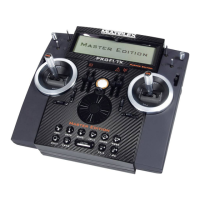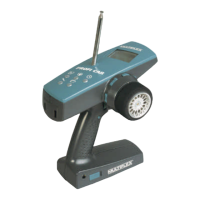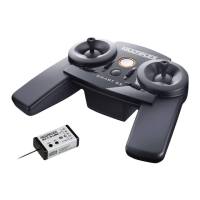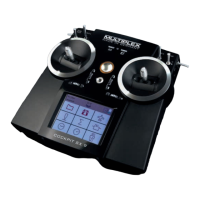This is how it works ...
- 17 -
I+i(
iIYIQ@MBFiiJG\iiIiS
[LE@ZiV@YDE@QiiI
-FLLFVDi\iZIUi5]
While the select field is still open you can press
the button and thereby alter the characteristic
to „V“. Its code then changes to V1.
2. Altering GYRO with the analogue switch
Return to Menu 2 by pressing , then press
to move to Menu 1. There you select the menu
for setting the number of points and assigning
switches by pressing . Press again to
open the select field for the servos and select
GYRO. This is servo 7 in the base types.
Now you can open the select field for the switch
by pressing and then select the analogue
switch V1. We want the effect of the gyro to be
reduced when you move the yaw stick away from
centre, and to achieve this the analogue switch
needs to be reversed by pressing the button.
The menu should look like this:
Y.i+(
[JFEW@ii\MTE@
iAY?ADiii\MTE@
-i/?YDiiiiiiW/I0i]
V1-A means that the analogue switch A is now
set to the V-characteristic and is controlled by
transmitter control A. The down arrow indicates
that the analogue switch has been reversed.
3. Setting a fixed value for the GYRO control
In the base types transmitter control H is as-
signed as the control for GYRO. No physical
control exists for this, and to ensure that a value
is actually fed to the servo we define a fixed
value for this control. This value simultaneously
represents the control signal for maximum gyro
sensitivity (gain).
From the menu shown (switch assignment) you
return to Menu 1 by pressing and then
switch to Transmitter control adjustment by
pressing .
Press again to open the select field and
search for the GYRO control, then press to
move on to selecting the options. There you
search for FIXED VALUE. If you now open the
adjust field by pressing , you can set an appro-
priate value using / or the digi-adjustor. The
menu will then look something like this:
\iN)i
V@YDEiiNi\MTE@iiiiiS
[LAUFKiWIQ.
-@Yiiiiiiiiiii5]
TIP:
You will see a flight mode in the top line of this menu,
and this indicates that the setting only applies to this
one flight mode. This means that, if you wish to sup-
press the gyro’s effect in more than one flight mode,
you will need to set this fixed value for all the other
flight modes too.
Rotor head systems
At present the model helicopter market is dominated
by three basic rotor head systems:
Schlueter
1. Heim
2. CPM (Collective Pitch Mixing)
in 90° or 120° arrangements.
The drawings below illustrate how these three sys-
tems work.
1. SCHLUETER
The SCHLUETER arrangement is the simplest form of
swashplate control system.
Each of the three functions COLL. PITCH, PITCH-
AXIS and ROLL is operated by its own single servo.
The swashplate does not move in the vertical direction
at all; it simply tilts.
3
6
2
This means that no mixers of any kind are required
for rotor head control in helicopters with Schlueter
mechanics.
When assigning the rotor head servos you can simply
assign the basic function to each servo.
COLL. PITCH for servo 6
PITCH AXIS for servo 3
ROLL for servo 2
This arrangement is used in the following base types
8. „Trainer, no mixer“ and
10. „Heli, no mixer“.
Direction of
flight
